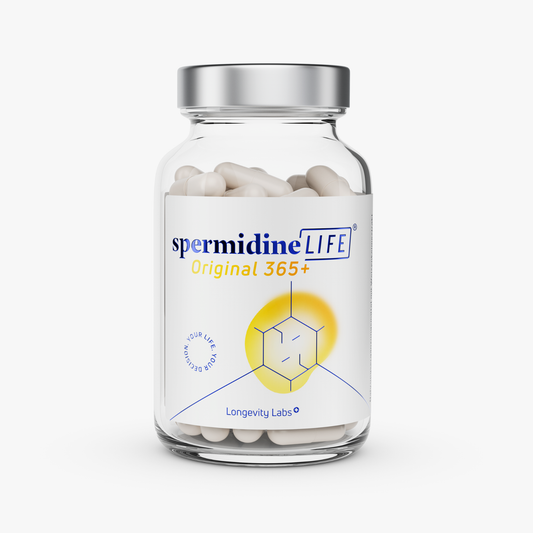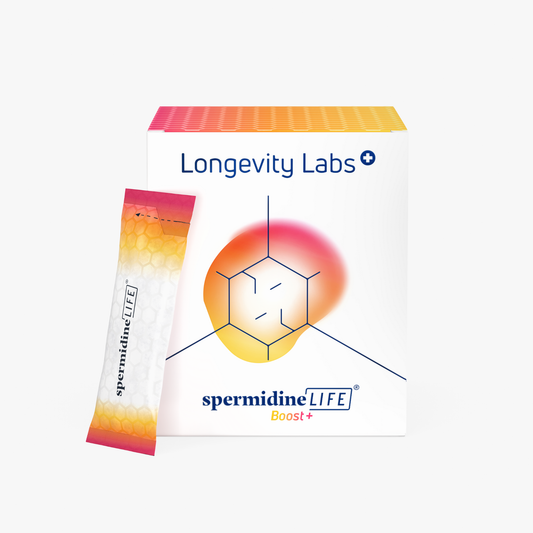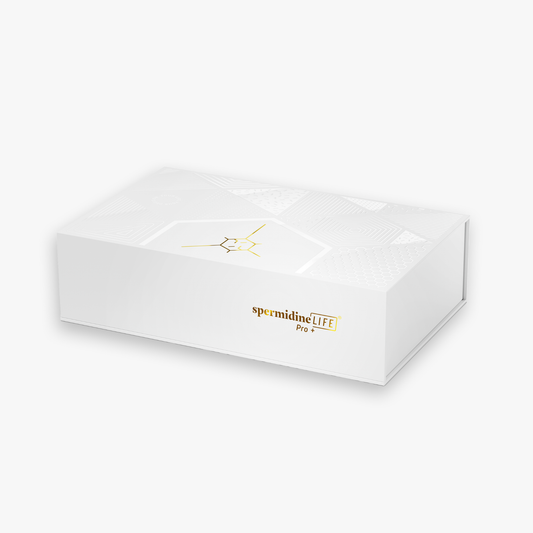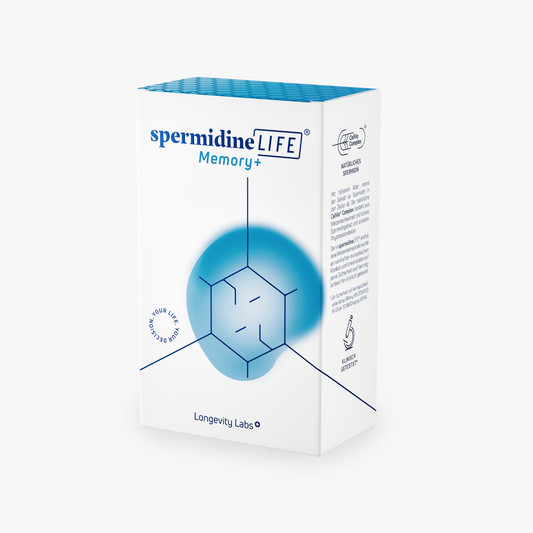
3 tips to help your cells get through the Christmas holidays well too
TLL LongevityLabsThe holidays should actually be a relaxing and contemplative time. But the fact is that unfortunately they usually make us look old. In the truest sense of the word, because at this time of year we do things that age our cells. What should you look out for to counteract this? We have 3 anti-ageing tips for your cells.
Let's start with the basics: in recent years, scientists have conducted in-depth research into the molecular and cellular processes of ageing and identified the hallmarks of ageing. These internal processes contribute in the long term to external damage that occurs with age and is therefore associated with the ageing process in our society. These include: the deregulation of the cell cycle, the shortening of telomeres and epigenetic changes. As all these processes are influenced by external factors such as the environment, toxins, radicals, lifestyle and diet, we can counteract them. And we can do this by simply reducing these substances and situations. So what can we do?
Tip 1: Maintain the cell cycle by avoiding oxidative and nitrosative stress
If our cell cycle, i.e. the autophagy or renewal of our cells, does not function correctly, our cells age prematurely and we age with them. The reasons for this premature ageing include oxidative and nitrosative stress.
Oxidative stress occurs when the balance between antioxidants and free oxygen radicals (OR) is disturbed. More precisely, when there are too many free oxygen radicals in our body, because then they attack the macromolecules and especially the DNA of our healthy cells instead of degenerated cells and pathogens. This results in around 800 cases of DNA damage in our body every hour. This adds up to around 19,000 incidents every day. The result? Possible cell mutations, premature cell ageing and increased cell death.
Nitrostress - or nitrosative stress - is triggered by nitric oxide radicals (NO). Researchers led by Professor Martin Pall have discovered the so-called NO/ONOO stress syndrome (pronunciation: "No, oh no"). Nitrostress occurs in 4 stages: At the first stage, short-term stressors such as infections, head injuries, stress, autoimmune diseases or certain substances have a triggering effect. In the second stage, a vicious circle of increased nitric oxide production and the resulting cell toxins begins. This is followed at stage three by various symptoms caused by increased levels of peroxynitrite (highly toxic!) or inflammatory messengers, oxidative stress and increased receptor activation in the brain. At stage four, essential mechanisms then take place locally in the brain, joints or intestines.
The exciting thing is that, according to Pall, this self-perpetuating NO/ONOO cycle can explain almost all symptoms associated with previously incurable diseases. For example, learning and memory disorders can be explained by excessive levels of nitric oxide in the brain. In this theory, sleep disorders are caused by increased levels of inflammatory cytokines and increased nitric oxide, as well as by a disturbance in neurotransmitter synthesis due to peroxinitrite.
So what can we do?
To protect our cells from oxidative and nitrosative stress, we should pay particular attention to our immune system and immune cells during this time, reduce stress, avoid alcohol and cigarettes and make sure we eat a balanced diet. This includes, above all, antioxidants such as zinc or EGCG from green tea, garlic or omega-3 fatty acids. After extensive Christmas meals, a short day of fasting can also stimulate the autophagy of our cells and get our cell cycle back on track.
Tip 2: Protect telomeres, and therefore the genetic material, from shortening
What are telomeres? Telomeres are, so to speak, protective caps from our genetic material that sit at the ends of our chromosomes and ensure that our genetic threads do not fray and are protected from damage. They are shortened with each cell division and can therefore be used as a marker for biological age. And that brings us to the heart of the problem. Because if the telomeres shorten too much, they no longer offer the genetic information sufficient protection against attacks - the cell goes into retirement. Researchers call this state of exhaustion "senescence".
But we can do something about it. Molecular biologist Elizabeth H. Blackburn from San Francisco University in California discovered this and was even awarded the Nobel Prize in Medicine for her work in 2009. What groundbreaking discovery did she make? Together with her team, she discovered an enzyme called telomerase, which ensures that the telomeres of our cells are constantly replenished - a kind of paste for the protective caps. It is mainly found in cells that divide frequently. For example, in skin and mucous membrane cells or germ and stem cells.
However, Elizabeth Blackburn also investigated how we can protect our telomeres. In one study, she showed that cell ageing can not only be stopped by a healthy lifestyle, but even reversed! The male test subjects changed their diet, exercised for 30 minutes a day and engaged in stress reduction. The result: after just three months, telomerase activity was increased by 30 to 80 %! In an examination after five years, the telomeres of the participants who had maintained the healthy lifestyle were even longer than at the start of the study - their chromosomes were therefore better protected against ageing at the time of the examination than five years previously.
So what do we need to do to boost our telomerase?
Sufficient exercise and sleep, mental balance and a healthy diet. Sounds familiar, doesn't it? Researchers have shown that these factors have a direct, positive effect on telomeres, whereas smoking, UV radiation and certain chemicals shorten our telomeres prematurely. So how about a little Christmas walk or an afternoon nap to protect your genetic material?
Tip 3: Reduce epigenetic changes through modulation
Our cells are impressive little works of nature. Not only are they capable of mutation or recombination, they can also adapt flexibly to certain conditions without changing their genetic material. Epigenetics is concerned with these mechanisms or influencing factors of cell change. It changes the expression of genes, but not the genetic code itself. In other words, it is the software that is run on our gene sequences - the hardware.
Epigenetic changes are generally not a bad thing. They occur naturally in our cells. Epigenetic marks, such as methyl groups, are located on the DNA and switch genes on or off. If a gene is switched on and active, it performs a certain function. Expression takes place. To use the image of the computer world once again: The epigenetic marks virtually connect the laptop to the printer so that the printout comes out.
Based on the methylation patterns of blood cells, researchers can determine the biological age, or cell age, of a person. With age, however, these emitted signals change and in turn influence the epigenetic markings. In particular, the methylation status of genes involved in DNA repair increases with age. The result: they are switched off or no longer switched on correctly. As a result, DNA repair no longer works and damage occurs. In other words: if the printer no longer works properly, paper jams occur.
But don't panic!
This DNA damage is also normal to a certain extent and can be corrected by nature. However, they become a problem when the epigenetic change processes are accelerated by external factors. The best-known epigenetic influencing factors include harmful chemicals and hormones released as a result of stress. However, age, the environment, lifestyle and diseases can also accelerate the processes.
So what modulation can we use to counteract this? Here too, a healthy lifestyle is the be-all and end-all for our cells. The type and amount of food we eat, exercise and sleep as well as stress and strain are factors that can influence epigenetic changes and thus also gene expression and contribute to premature ageing.
Our conclusion:
Even if science still needs some time to present us with solutions to protect against premature cell deterioration, damaged telomeres and epigenetic changes, we can already do our part to take precautions to protect our cells and not age from the inside before their time.






